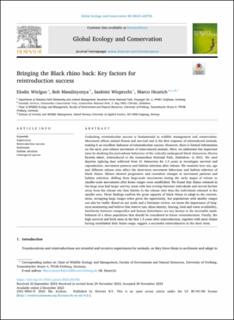| dc.description.abstract | Evaluating reintroduction success is fundamental to wildlife management and conservation. Movement affects animal fitness and survival and is the first response of reintroduced animals, making it an excellent indicator of reintroduction success. However, there is limited information on the early post-release movement of reintroduced animals. Here, we addressed this important issue by studying the post-release behaviour of the critically endangered black rhinoceros, Diceros bicornis minor, reintroduced to the Gonarezhou National Park, Zimbabwe, in 2021. We used daytime sighting data collected from 21 rhinoceros for 1.5 years to investigate survival and reproduction, movement patterns and habitat selection after release. We examine how sex, age and different release sites affect the short-term movement behaviour and habitat selection of black rhinos. Rhinos showed progressive and consistent changes in movement patterns and habitat selection, shifting from large-scale movements during the early stages of release to smaller-scale movements after home ranges were established. We found that rhinos released in the large area had larger activity areas with less overlap between individuals and moved further away from the release site (less fidelity to the release site) than the individuals released in the smaller area. These findings confirm the great capacity of black rhinos to adapt to the environment, occupying large ranges when given the opportunity, but populations with smaller ranges can also be viable. Based on our study and a literature review, we stress the importance of long-term monitoring and believe that reserve size, rhino density, fencing, food and water availability, familiarity between conspecifics and human disturbance are key factors in the successful establishment of a rhino population that should be considered in future reintroductions. Finally, the high survival and birth rates in the first 1.5 years after reintroduction, together with most rhinos having established their home range, suggest a successful reintroduction in the short term. | en_US |

